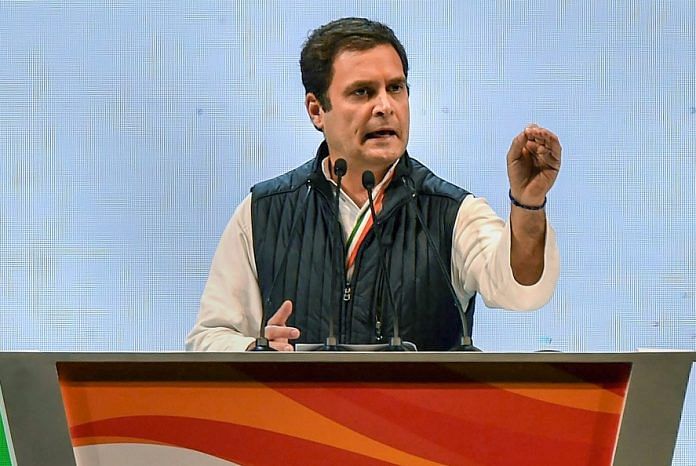At the Congress plenary session in the capital, party president indicates he won’t be afraid to hurt senior leaders; puts the focus on the youth.
New Delhi: ‘Change is now’ was the theme of the Congress’s 84th plenary session, and in keeping with the theme, party president Rahul Gandhi warned colleagues that he would take hard decisions even if it meant hurting some.
Considering how low it has sunk in terms of performance as well as popularity, an organisational reshuffle appears to be the first step of in the larger scheme of resurrecting the Congress.
But then again, upon taking over as party vice-president in January 2013 at the Jaipur session, Gandhi had made similar noises, talking about the need for leaders to meet workers, the need to respect workers, for youngsters to be given a chance, etc.
Five years on, Gandhi’s track record on ‘change’ doesn’t inspire much confidence, and the road ahead seems to go sharply uphill.
Leadership crisis
Since taking over the vice-presidency, Gandhi virtually had a free hand over all appointments, and at first, he did try to introduce younger leaders at the top of Pradesh Congress Committees – for example, Sachin Pilot in Rajasthan, Arun Yadav in Madhya Pradesh, and Ashok Tanwar in Haryana.
But after a while, his chosen ones started facing the ire of senior state leaders, and today, barring Pilot, most of the others have become presidents only in name, who could be replaced at any time.
Even in his time as party general secretary, he had attempted to develop a new leadership in Himachal Pradesh, ahead of the 2012 assembly polls. But his attempts were jolted when senior leader Virbhadra Singh threatened to split the party. Gandhi had to step back, and the then-78 year-old Singh became chief minister again.
In the last four years, as his mother and former party chief Sonia Gandhi took more of a back seat and Rahul himself became the face of the party, the Congress lost virtually the entire country, forming fresh governments only in Punjab and the Union Territory of Puducherry. And even in Punjab, the handpicked Partap Singh Bajwa was left by the wayside and the Congress rode Captain Amarinder Singh’s leadership back to power after 10 years.
When the party chief spoke of the wall between workers and leaders, he was clearly referring to the ‘inaccessible’ senior leadership. But Gandhi himself has been at the receiving end of that complaint when leaders switch to other parties – Assam’s Himanta Biswa Sarma, the architect of the BJP’s successes in the northeast, being a prime example.
Youth-centric strategy
It’s clear that Gandhi is about to announce his new team soon, which will deepen state-level differences at a time when elections to many assemblies and the Lok Sabha are around the corner.
He dropped another hint about the expected chopping and changing when he urged the leaders to “fight among yourselves after the elections. But for now, for the coming few months, work as a unit to ensure victory for the party”.
Gandhi’s new strategy seems to be a lot more youth-centric than before – 25 per cent AICC members selected this time are youth.
In addition, the format for the plenary was also changed – no leader sat on the stage. Gandhi justified it by saying: “I have kept the stage vacant for the young people of the country to come and occupy it. This is your stage; take it from us.”
Providing an alternative to Modi and BJP
Gandhi’s speech featured nothing new in terms of attacks on the Narendra Modi government – it sounded pretty much like a rehash of his election speeches from across the country. Issues like demonetisation, unemployment, and the agrarian crisis remained the focal point.
However, he did pay heed to a demand often heard on the ground during the Gujarat assembly elections – for the Congress to stop merely highlighting problems and start providing alternative solutions.
Gandhi briefly spoke about the Congress’s vision, especially for farmers and job-seeking youth. One of the ideas he mentioned was to put up food parks in every district, in order to minimise wastage and offer remunerative pricing to farmers. On the issue of unemployment, his idea is to link skills and technology with the help of banks to create jobs at the district level.
He also said if the party came back to power, a farm loan waiver could be considered again, similar to the one given under UPA-II.
But despite all the positive noises, the past indicates that Gandhi has miles to go before he can prop up the grand old party on its own legs again.




Farm loan waiver 2.0, an additional tax on the top 1% of the population, all seems like reheated tomato soup. It progressed from Garibi Hatao to NAC. If the Congress is to turbocharge growth, absent which job creation will remain dismal, it needs to articulate a clear, reform oriented vision for the future of India’s young. It seems to be relying unduly on the incumbent’s inability to fulfil important campaign promises.